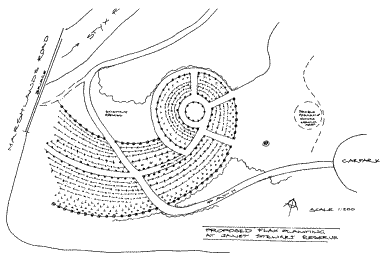The Janet Stewart Reserve is a renewed source of traditional Māori weaving materials. It borders the Lower Styx River and covers an area of just over two hectares. In 1993, on the death of landowner Edward Stewart, the area was gifted to the Christchurch City Council. Stewart's will contained instructions that the farmland be converted into a reserve that would be named in memory of his mother, Janet Stewart. Historically this landscape formed a natural part of the Styx River floodplain, and was covered in native vegetation species - ferns, tussocks and raupō swamp. At the time of the gifting into Council ownership, the land was a reasonably low lying grassy paddock with a boxed drain running through it.
The initial stage of the project saw the creation of a landscape design that was tested by public consultation. The concept recognised the reserve's important relationship to the Styx River and its high natural values associated with the waterway. The public consultation process involved distributing pamphlets, outlining the concept plan, and organising public meetings with people to review the design plan in detail and discuss the concepts and relevant issues.
The final form of the Reserve evolved to include the creation of a lake, jetty, walkways and car park. Native plantings were used to provide a habitat feature for the reserve. The boxed waterway was released to form a large pond that was surrounded by riparian planting. The council also worked closely with Te Korari and Landcare Research in the planting of a pā harakeke - a planted area of special flaxes and toetoe suitable for traditional Māori weaving. Eventually, this reserve will be linked with the Malvern Scout Group redevelopment project that is located to the north-east of Janet Stewart Reserve.
The scale of the project meant the development process needed to be spread over a six year period. Community planting days were organised by the Christchurch City Council, the Malvern Scout Group and Te Korari. Native vegetation species such as the toetoe and harakeke were grouped into large plots for maximum visual effect. The work was achieved in partnership with the Stewart family, Christchurch City Council, Burwood/Pegasus Community Board, Waiora Trust, Landcare Research, Te Korari, the Malvern Scout Group, The Guardians of the Styx and members of the wider local community. The results of the project are many and varied:
- Ecology
- Improved wildlife habitat for birds and aquatic organisms.
- Heritage
- Recognition of the Stewart family through reserve name;
Preservation of exotic tree species that provided the original stake for the farmhouse food safe. - Cultural
- Re-vegetated raw plants now supply materials for traditional Māori weaving, e.g. pā harakeke plantings at the Marshland Road / Lower Styx crossing.
- Landscape
- Improved viewing access to the river with enhanced views of native vegetation plantings.
- Recreation
- Greater access to the Styx River for recreational activities such as picnicking, walking and boating (with jetty).
- Drainage
- Flood storage maintained;
Improved stability of riverbank;
Enhanced water quality entering Styx River from Gibsons Drain.
R.C.
This page reproduces information from page 6 and 7 of the booklet Pūawaitanga o te Ringa - Fruits of our busy hands



